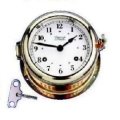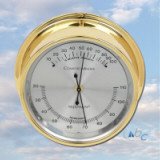We've listed several commonly used clock terms below -
CLOCK TERMS
Analog: Analog is the traditional style of time keeping, in which the hours and minutes are represented by an hour and minute hand, and a clock dial displaying the hours.
Arabic dial: Most common numerals (1, 2, 3, 4, etc...) used on a dial, as compared to Roman numerals (I, II, III, IV)
Ascending alarm: Alarm that increases alarm volume - usually automatically at pre-set intervals.
Atomic Clock: There are 2 common uses of the term "atomic clock".
(1) Used to refer to the Atomic Clock maintained by the National Bureau of Standards (NIST) in Fort Collins, CO. (or similar stations in other countries). This clock is interfaced with a radio transmitter (callsign WWV, or WWVB), which transmits a signal from the clock which is used as a time standard for most radio controlled clocks, as well as television and radio stations, and government agencies.
(2) The term "atomic clock" is also used to refer to clocks which syncronize themselves to the radio signals from the atomic clock mentioned above. These clocks are actually radio controlled clocks, which use a built in receiver to syncronize displayed time (and usually date) to the NIST clock mentioned above.
Automatic Movement: Also called an "kenetic" movement - found in wristwatches. The motion of the arm moves a rotor within the movement. With the older styles, this movement winds the mainspring. With newer styles, the rotor is attached to micro electronic components which generate electrical voltage when moved. This voltage is then stored in a storage cell which powers the movement. Several "hybrid" types have evolved, which use both kenetic and solar energy to store power in a storage cell. These types of movements typcially never require a battery.
Bell Silencer: A small switch normally on the back of striking or chiming case clocks, which allows the bell cycle to be turned off at night.
Beveled glass: Glass used on the sides and front of a clock case, which has its outside edges ground and polished at an angle to providing a beautiful decorative effect.
Bezel: The grooved rim around the dial into which the crystal is set.
Chime-selector: A feature on many case clocks which allows the chime tune or melody to be changed - normally a small switch of some kind on the rear of the clock.
Crystal: Normally made of glass or high impact plastic, covers the dial for protection.Dial: The face of the clock on which hours, seconds, etc. are indicated.
Digital: Digital clocks display the time with a series of digital numbers, rather than the traditional hour and minute hands used on analog clocks.
Forged Brass: Forged brass is normally preferred to cast, or rolled brass cases, and is typically of higher quality. In terms of weight, forged brass casework is much heavier, and of a more endearing quality. The forging process refines the structure of the brass, and improves the physical properties of the brass, and is more consistent than rolled, or cast brass. Forged brass does not contain the porosity, or defects more commonly found with other types of casework.
Hands: Indicators or "hands", usually metal or plastic, sometimes decorative, which indicate the hours, minutes and seconds on the dial of a clock or watch.
Kenetic movement: Also called an "automatic" movement - found in wristwatches. The motion of the arm moves a rotor within the movement. With the older styles, this movement winds the mainspring. With newer styles, the rotor is attached to micro electronic components which generate electrical voltage when moved. This voltage is then stored in a storage cell which powers the movement. Several "hybrid" types have evolved, which use both kenetic and solar energy to store power in a storage cell. These types of movements typcially never require a battery.
Key-wound movement (also Mechanical Movement): A clock which uses a key to wind the main spring that powers the clock movement. Key-wound movements generally run the clock for up to eight days before needing manual rewinding. Most clock makers recommend winding at 7 day intervals, at about the same time each week for maximum accuracy. Key-wound, or Mechanical movments do not normally provide the accuracy of a quartz movement.
Liquid crystal display (LCD): A form of digital display used in clocks in which electrical current is applied to a layer of liquid crystals between two layers of transparent material. Placement of the crystals form the digits of the display.
Light emitting diode (LED): Similar to LCD, a display used in clocks in which an actual electronic component (the diode) illuminates to form the display. The actual color of the display is normally determined by the colored overlay placed on the clock face - usually red, or bluegreen.
Movement: The inner mechanism of a clock or watch. Several types including key-wound, weight-driven (grandfather clocks), electric or quartz, and kenetic.
Pendulum: A balanced swinging rod and weight (bob) suspended below the clock movement. Pendulum determines the rate at which the movement measures time.
Quartz movement: Electronic impulses pass from a battery through a quartz crystal, power
ing the movement of the clock at regular intervals.
Radio controlled clock: See Atomic Clocks above
Visit us online at http://bellclocks.coma Division of Windward Instruments





